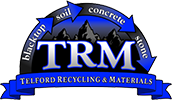PLEASE NOTE: Fill dirt source approval is required prior to delivery. Please have the required forms completed and have approval before arriving to our facility.
Fill Dirt – We offer fill dirt and topsoil at competitive pricing. Fill dirt is a combination of natural materials (subsoil, rock, sand, clay, etc.) that is used to level or elevate the ground. Simply put, fill dirt is any type of dirt that is used to fill in space. Fill dirt can be used for a lot of things, and some projects require higher quality soil than others.
Reclamation Fill
refers to uncontaminated, non-water-soluble, non-decomposable, inert solid material including: soil; rock; stone; gravel; unused bricks (provided no painted surfaces); block and concrete (provided no painted surfaces); block and concrete containing metal internally, which shall mean that all metal shall be removed from the surface of the block and/or concrete so that only rebar or other metals that are embedded in the concrete remain; and incidental asphalt in an a mount of 25% or less on average in any one load by volume.
Clean fill dirt
refers to dirt that is free of materials dangerous to humans, animals, and the environment. Clean fill does not mean that the dirt is screened and found to be free to debris and organic materials, which is a common misconception. It simply means the fill dirt is environmentally clean and free of hazardous materials.
Common fill dirt
is cheap dirt normally dug directly from the ground and delivered without being screened, cleaned, or tested. Because of this, it usually contains a lot of clay, as well as rock and plant roots, making it difficult to work with by hand.
Screened fill dirt
is clean fill that has been run through a dirt screening machine to sort out debris larger than roughly 5/8 inch. The screening process adds to the cost, but it’s very helpful if you plan to spread the fill using a wheelbarrow and shovel. That’s because fill often contains clay and heavy rock, which takes up space and is difficult to move.
Select fill dirt
is clean fill that has been run through a dirt screening machine to sort out debris larger than roughly 5/8 inch. The screening process adds to the cost, but it’s very helpful if you plan to spread the fill using a wheelbarrow and shovel. This type of topsoil is an excellent choice if you’re going to grow different plants, flowers, vegetables, or lay a lawn.
Topsoil
is a mixture of compost and sand that contains the nutrients necessary for growing things. It’s used for the top layer of dirt or soil on the ground, hence the name topsoil, with subsoil beneath it. It’s commonly used for landscaping and gardening.
Concrete Recycling is becoming an increasingly popular way to utilize aggregate left behind when structures or roadways are demolished. In the past, this rubble was disposed of in landfills, but with more attention being paid to environmental concerns, concrete recycling allows reuse of the rubble while also keeping construction costs down.
- Clean Concrete
A ‘clean’ load is defined as concrete and cement. Brick, block, slate, and cement is also accepted.
- Concrete with wire
Concrete with wire is the same as above except it also has any type/size of steel in the load.
- Concrete with rebar
Concrete with rebar is the same as above except it also has any heavy steel in the load.
Asphalt Recycling (broken asphalt or millings) – Asphalt pavement is the most recycled material in the USA. With a 99% recycling rate, asphalt pavement is the most recycled product in the USA, easily beating materials that are more commonly associated with recycling, such as aluminum (the recycling rate for aluminum cans is a mere 55%). Statistics from the USA Environmental Protection Agency (EPA) show that asphalt pavement recycling has topped the recycling charts for over twenty years.
It is estimated that recycling of asphalt pavements saves the American taxpayer more than $2.5 billion per year. It also saves thousands of acre-feet of landfill space each year. According to the Asphalt Pavement Alliance, reclaimed asphalt pavement (RAP) can be recycled into the pavement that is as high, or even higher, in quality as pavements made of all-virgin materials. And the same material can be recycled again and again; it never loses its value.
The asphalt cement—the glue that holds the pavement together—retains its ability to function as glue or cement, so that it is reused for its original purpose. The aggregates (rocks, sand, and gravel) in the original pavement are also conserved.
Offsite Crushing Available
- Sandvik Jawcrusher QJ341
- Sandvik QE341
- Extec S5 Screener
- Edge Track Stacker
- Cat 330 Trackhoe
- Cat 972 Wheel Loader
Project Contract Pricing is available. Please
contact us for further information.
